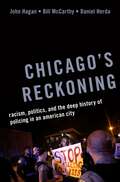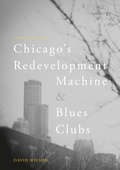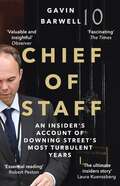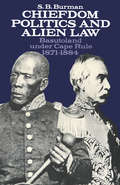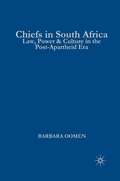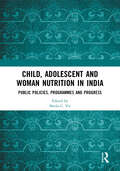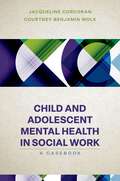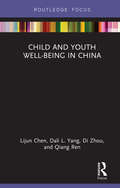- Table View
- List View
Chicago's Industrial Decline: The Failure of Redevelopment, 1920–1975
by Robert LewisIn Chicago's Industrial Decline Robert Lewis charts the city's decline since the 1920s and describes the early development of Chicago's famed (and reviled) growth machine. Beginning in the 1940s and led by local politicians, downtown business interest, financial institutions, and real estate groups, place-dependent organizations in Chicago implemented several industrial renewal initiatives with the dual purpose of stopping factory closings and attracting new firms in order to turn blighted property into modern industrial sites. At the same time, a more powerful coalition sought to adapt the urban fabric to appeal to middle-class consumption and residential living. As Lewis shows, the two aims were never well integrated, and the result was on-going disinvestment and the inexorable decline of Chicago's industrial space.By the 1950s, Lewis argues, it was evident that the early incarnation of the growth machine had failed to maintain Chicago's economic center in industry. Although larger economic and social forces—specifically, competition for business and for residential development from the suburbs in the Chicagoland region and across the whole United States—played a role in the city's industrial decline, Lewis stresses the deep incoherence of post-WWII economic policy and urban planning that hoped to square the circle by supporting both heavy industry and middle- to upper-class amenities in downtown Chicago.
Chicago's Reckoning: Racism, Politics, and the Deep History of Policing in an American City
by John Hagan Bill McCarthy Daniel HerdaA searing examination of the long history of police misconduct and political corruption in Chicago that produced the city's current racial reckoning Chicago faces a racial reckoning. For over 50 years, Chicago Mayors Richard J. and Richard M. Daley were at the helm of a law-and-order dynasty that disadvantaged predominantly Black and Brown neighborhoods and covered up heinous crimes against Black men. During his 1980-2012 tenure as State's Attorney and Mayor, Richard M. Daley (son of Richard J. Daley) led a law enforcement bureaucracy which permitted police detective John Burge to supervise the torture of over 100 Black men on Chicago's South and West Sides. Misguided policies on "gangs, guns, and drugs," support for a racialized code of silence and police misconduct, and a lack of meaningful punishment, have ensured that these leaders' effects on Chicago are still sorely felt. In this book, John Hagan, Bill McCarthy, and Daniel Herda confront the complicated history of race, politics, and policing in Chicago to explain how crime works from the top-down through urban political machines and the elite figures who dominate them. The authors argue that the Daleys' law enforcement system worked largely to benefit and protect White residential areas and business districts while excluding Black and Brown Chicagoans and concentrating them in highly segregated neighborhoods. The stark contradiction between the promise "to serve and protect" and the realities of hyper-segregation and mass incarceration created widespread cynicism about policing that remains one of the most persistent problems of contemporary Chicago law enforcement. By holding a sociological lens up to the history of this quintessential American city, Chicago's Reckoning reveals new insights into the politics of crime and how, until we come to terms with our history and the racial and economic divisions it created, these dynamics will continue to shape our national life.
Chicago's Reckoning: Racism, Politics, and the Deep History of Policing in an American City
by John Hagan Bill McCarthy Daniel HerdaA searing examination of the long history of police misconduct and political corruption in Chicago that produced the city's current racial reckoning Chicago faces a racial reckoning. For over 50 years, Chicago Mayors Richard J. and Richard M. Daley were at the helm of a law-and-order dynasty that disadvantaged predominantly Black and Brown neighborhoods and covered up heinous crimes against Black men. During his 1980-2012 tenure as State's Attorney and Mayor, Richard M. Daley (son of Richard J. Daley) led a law enforcement bureaucracy which permitted police detective John Burge to supervise the torture of over 100 Black men on Chicago's South and West Sides. Misguided policies on "gangs, guns, and drugs," support for a racialized code of silence and police misconduct, and a lack of meaningful punishment, have ensured that these leaders' effects on Chicago are still sorely felt. In this book, John Hagan, Bill McCarthy, and Daniel Herda confront the complicated history of race, politics, and policing in Chicago to explain how crime works from the top-down through urban political machines and the elite figures who dominate them. The authors argue that the Daleys' law enforcement system worked largely to benefit and protect White residential areas and business districts while excluding Black and Brown Chicagoans and concentrating them in highly segregated neighborhoods. The stark contradiction between the promise "to serve and protect" and the realities of hyper-segregation and mass incarceration created widespread cynicism about policing that remains one of the most persistent problems of contemporary Chicago law enforcement. By holding a sociological lens up to the history of this quintessential American city, Chicago's Reckoning reveals new insights into the politics of crime and how, until we come to terms with our history and the racial and economic divisions it created, these dynamics will continue to shape our national life.
Chicago’s Redevelopment Machine and Blues Clubs
by David WilsonThis book examines the conflict surrounding the latest redevelopment frontier in Chicago: the city’s South Side blues clubs and blocks. Like Chicago, cities such as Cleveland, St. Louis, Boston, Washington D.C., Indianapolis, Milwaukee, and Philadelphia are experiencing a new redevelopment machine: one of tyrannizing and fear. Its actors are adroit at working via the creation of fear to “terror-redevelop” in these historically neglected neighborhoods. The book also discusses the powerful race and class-based politics in Chicago’s blues clubs that resist such change. A “leisure as resistance” framework represents the latest innovative form of opposition to the transformation of these historic sites.
Chicago’s Redevelopment Machine and Blues Clubs
by David WilsonThis book examines the conflict surrounding the latest redevelopment frontier in Chicago: the city’s South Side blues clubs and blocks. Like Chicago, cities such as Cleveland, St. Louis, Boston, Washington D.C., Indianapolis, Milwaukee, and Philadelphia are experiencing a new redevelopment machine: one of tyrannizing and fear. Its actors are adroit at working via the creation of fear to “terror-redevelop” in these historically neglected neighborhoods. The book also discusses the powerful race and class-based politics in Chicago’s blues clubs that resist such change. A “leisure as resistance” framework represents the latest innovative form of opposition to the transformation of these historic sites.
Chicana/o Subjectivity and the Politics of Identity: Between Recognition and Revolution
by C. GallegoThis book traces the influence of Hegel's theory of recognition on different literary representations of Chicano/a subjectivity, with the aim of demonstrating how the identity thinking characteristic of Hegel's theory is unwillingly reinforced even in subjects that are represented as rebelling against liberal-humanist ideologies.
Chicano Novels And The Politics Of Form: Race, Class, And Reification (Class : Culture Ser. (PDF))
by Marcial GonzalezThe field of Mexican American fiction has exploded since the 1990s, yet there has been relatively little critical assessment of this burgeoning area in American literature. ""Chicano Novels and the Politics of Form"" is a provocative and timely study of literary form that focuses on the fiction of five writers whose work spans a century: Maria Amparo Ruiz de Burton, Oscar Zeta Acosta, Danny Santiago, and Cecile Pineda.Drawing on the Marxist concept of reification to examine the connections between social history and narrative, Marcial Gonzalez highlights the relationship between race and class in these works and situates them as historical responses to Mexican American racial, political, and social movements since the late nineteenth century.The book sheds light on the relationship between politics and form in the novel, an issue that has long intrigued literary scholars. This timely and original study will appeal to scholars and students of American literature, ethnic studies, Latino studies, critical race theory, and Marxist literary theory.This book explores the relationship between race and class and between politics and literary form in major works of Chicano literature over the last hundred years.
The Chicken Trail: Following Workers, Migrants, and Corporations across the Americas
by Kathleen C. SchwartzmanIn The Chicken Trail, Kathleen C. Schwartzman examines the impact of globalization—and of NAFTA in particular—on the North American poultry industry, focusing on the displacement of African American workers in the southeast United States and workers in Mexico. Schwartzman documents how the transformation of U.S. poultry production in the 1980s increased its export capacity and changed the nature and consequences of labor conflict. She documents how globalization—and NAFTA in particular—forced Mexico to open its commodity and capital markets, and eliminate state support of corporations and rural smallholders. As a consequence, many Mexicans were forced to abandon their no longer sustainable small farms, with some seeking work in industrialized poultry factories north of the border. By following this chicken trail, Schwartzman breaks through the deadlocked immigration debate, highlighting the broader economic and political contexts of immigration flows. The narrative that undocumented worker take jobs that Americans don’t want to do is too simplistic. Schwartzman argues instead that illegal immigration is better understood as a labor story in which the hiring of undocumented workers is part of a management response to the crises of profit making and labor-management conflict. By placing the poultry industry at the center of a constellation of competing individual, corporate, and national interests and such factors as national debt, free trade, economic development, industrial restructuring, and African American unemployment, The Chicken Trail makes a significant contribution to our understanding of the implications of globalization for labor and how the externalities of free trade and neoliberalism become the social problems of nations and the tragedies of individuals.
Chickenizing Farms and Food: How Industrial Meat Production Endangers Workers, Animals, and Consumers
by Ellen K. SilbergeldOver the past century, new farming methods, feed additives, and social and economic structures have radically transformed agriculture around the globe, often at the expense of human health. In Chickenizing Farms and Food, Ellen K. Silbergeld reveals the unsafe world of chickenization;¢;‚¬;€?big agriculture;€™s top-down, contract-based factory farming system;¢;‚¬;€?and its negative consequences for workers, consumers, and the environment. Drawing on her deep knowledge of and experience in environmental engineering and toxicology, Silbergeld examines the complex history of the modern industrial food animal production industry and describes the widespread effects of Arthur Perdue;€™s remarkable agricultural innovations, which were so important that the US Department of Agriculture uses the term chickenization to cover the transformation of all farm animal production. Silbergeld tells the real story of how antibiotics were first introduced into animal feeds in the 1940s, which has led to the emergence of multi-drug-resistant pathogens, such as MRSA. Along the way, she talks with poultry growers, farmers, and slaughterhouse workers on the front lines of exposure, moving from the Chesapeake Bay peninsula that gave birth to the modern livestock and poultry industry to North Carolina, Brazil, and China.Arguing that the agricultural industry is in desperate need of reform, the book searches through the fog of illusion that obscures most of what has happened to agriculture in the twentieth century and untangles the history of how laws, regulations, and policies have stripped government agencies of the power to protect workers and consumers alike from occupational and food-borne hazards. Chickenizing Farms and Food also explores the limits of some popular alternatives to industrial farming, including organic production, nonmeat diets, locavorism, and small-scale agriculture. Silbergeld;€™s provocative but pragmatic call to action is tempered by real challenges: how can we ensure a safe and accessible food system that can feed everyone, including consumers in developing countries with new tastes for western diets, without hurting workers, sickening consumers, and undermining some of our most powerful medicines?
The Chief Justice: Appointment and Influence
by Artemus Ward David J DanelskiThe Chief Justice brings together leading scholars of the courts who employ social science theory and research to explain the role of the Chief Justice of the U.S. Supreme Court. They consider the chief justice’s appointment, office, powers, and influence both within the Court and in the American system of government more generally. The chief justice presides over oral arguments and the justices’ private conferences. The chief justice speaks first in those conferences, presents cases and other matters to the other justices, and assigns the Court’s opinions in all cases in which the chief justice votes with the majority. In addition, the chief justice presides over the Judicial Conference of the United States, a policy-making body composed of lower-court federal judges. As Chief Justice Charles Evans Hughes wrote, the Chief Justice of the U.S. Supreme Court is “the most important judicial officer in the world.”
Chief of Staff: Notes from Downing Street
by Gavin BarwellOnce a more sedate affair, since 2016, British politics has witnessed a barrage of crises, resignations and general elections. As Brexit became logjammed, Theresa May's premiership was the most turbulent of all. In her darkest hour, following the disastrous 2017 election, she turned to Gavin Barwell to restore her battered authority. He would become her Chief of Staff for the next two years - a period punctuated by strained negotiations, domestic tragedy, and intense political drama.In this gripping insider memoir, Barwell reveals what really went on in the corridors of power - and sheds a vital light on May, the most inscrutable of modern prime ministers. He was by her side when she negotiated her Brexit deal, met Donald Trump, heard about the poisoning of the Skripals in Salisbury, responded to the Grenfell Tower fire, met Jeremy Corbyn and Keir Starmer to broker a cross-party Brexit agreement - and ultimately made the decision to stand down as Prime Minister. Revealing how government operates during times of crisis, this will become the definitive record of a momentous episode in Britain's recent political history.
Chief of Station, Congo: Fighting the Cold War in a Hot Zone
by Lawrence DevlinLarry Devlin arrived as the new chief of station for the CIA in the Congo five days after the country had declared its independence, the army had mutinied, and governmental authority had collapsed. As he crossed the Congo River in an almost empty ferry boat, all he could see were lines of people trying to travel the other way-out of the Congo. Within his first two weeks he found himself on the wrong end of a revolver as militiamen played Russian-roulette, Congo style, with him. During his first year, the charismatic and reckless political leader, Patrice Lumumba, was murdered and Devlin was widely thought to have been entrusted with (he was) and to have carried out (he didn't) the assassination. Then he saved the life of Joseph Desire Mobutu, who carried out the military coup that presaged his own rise to political power. Devlin found himself at the heart of Africa, fighting for the future of perhaps the most strategically influential country on the continent, its borders shared with eight other nations. He met every significant political figure, from presidents to mercenaries, as he took the Cold War to one of the world's hottest zones. This is a classic political memoir from a master spy who lived in wildly dramatic times.
Chief of Station, Congo: Fighting the Cold War in a Hot Zone
by Lawrence DevlinLarry Devlin arrived as the new chief of station for the CIA in the Congo five days after the country had declared its independence, the army had mutinied, and governmental authority had collapsed. As he crossed the Congo River in an almost empty ferry boat, all he could see were lines of people trying to travel the other way -- out of the Congo. Within his first two weeks he found himself on the wrong end of a revolver as militiamen played Russian-roulette, Congo style, with him. During his first year, the charismatic and reckless political leader, Patrice Lumumba, was murdered and Devlin was widely thought to have been entrusted with (he was) and to have carried out (he didn't) the assassination. Then he saved the life of Joseph Desire Mobutu, who carried out the military coup that presaged his own rise to political power. Devlin found himself at the heart of Africa, fighting for the future of perhaps the most strategically influential country on the continent, its borders shared with eight other nations. He met every significant political figure, from presidents to mercenaries, as he took the Cold War to one of the world's hottest zones. This is a classic political memoir from a master spy who lived in wildly dramatic times.
Chiefdom Politics and Alien Law: Basutoland under Cape Rule 1871-1884 (pdf) (St Antony's Series)
by S. B. BurmanChiefs in South Africa: Law, Culture, and Power in the Post-Apartheid Era
by NA NAThis book examines the ongoing resurgence of traditional power structures in South Africa. Oomen assesses the relation between the changing legal and socio-political position of traditional authority and customary law and what these changes can teach us about the interrelation between law, politics, and culture in the post-modern world.
Child Abuse and Neglect: Biosocial Dimensions - Foundations of Human Behavior
by Jane B. LancasterChild Abuse and Neglect is the third volume sponsored by the Social Science Research Council. The goals of these volumes include the development of a biosocial perspective and its application to the interface between biological and social phenomena in order to advance the understanding of human behavior.Child Abuse and Neglect applies the biosocial perspective to child maltreatment and maladaptation in parent-child relations. The biosocial perspective is particularly appropriate for investigating parent behavior since the family is the universal social institution in which children are born and reared, in which cultural traditions and values are transmitted, and in which individuals fulfill their biological potential for reproduction, growth, and development. The volume examines biological substrates and social and environmental contexts as determinants of parent behavior. By identifying areas in which contemporary human parent behaviors conform with and depart from evolutionary and historical patterns and assessing the overall costs and benefits, it permits their objective assessment in terms of modern circumstances. In analyzing evolutionary and historical variations in parent behavior and assessing their costs and benefits, the book makes possible an objective assessment of contemporary variations. Its analysis of the occurrence of child abuse in past history and in other cultures and species advances our ability to predict the probability of child abuse and neglect in various social and ecological contexts.
Child Abuse and Neglect: Biosocial Dimensions - Foundations of Human Behavior
by Jane B. LancasterChild Abuse and Neglect is the third volume sponsored by the Social Science Research Council. The goals of these volumes include the development of a biosocial perspective and its application to the interface between biological and social phenomena in order to advance the understanding of human behavior.Child Abuse and Neglect applies the biosocial perspective to child maltreatment and maladaptation in parent-child relations. The biosocial perspective is particularly appropriate for investigating parent behavior since the family is the universal social institution in which children are born and reared, in which cultural traditions and values are transmitted, and in which individuals fulfill their biological potential for reproduction, growth, and development. The volume examines biological substrates and social and environmental contexts as determinants of parent behavior. By identifying areas in which contemporary human parent behaviors conform with and depart from evolutionary and historical patterns and assessing the overall costs and benefits, it permits their objective assessment in terms of modern circumstances. In analyzing evolutionary and historical variations in parent behavior and assessing their costs and benefits, the book makes possible an objective assessment of contemporary variations. Its analysis of the occurrence of child abuse in past history and in other cultures and species advances our ability to predict the probability of child abuse and neglect in various social and ecological contexts.
Child, Adolescent and Woman Nutrition in India: Public Policies, Programmes and Progress
by Sheila C. VirIn the last decade, addressing the persistent problem of maternal, infant, young child and adolescent malnutrition in India has gained significant attention. With the well-established serious implications of malnutrition on mortality and morbidity; mental health and cognitive development; activity and productivity and overall economic development, today there is an unprecedented political commitment to improving the grave woman and child nutrition scenario in the country. POSHAN ABHIYAAN (Nutrition Mission) was launched in a Mission mode by the Honourable Prime Minister of India on March 8, 2018, followed by measures for an effective implementation of an integrated nutrition strategy through POSHAN 2.0 in 2022. The book with 15 chapters tracks the history of evolvement of public nutrition policies and strategies, presents an update on the nutrition scenario, analyses the experiences and synthesises emerging lessons in the prevention and control of malnutrition. Additionally, the book includes chapters with details of each of the various government systems such as Health, ICDS, NRLM, PDS, Education/MDM, Water-Sanitation that provide lead in mainstreaming nutrition actions that directly or indirectly impact on accelerating the improvement of the nutrition situation of women, adolescents and children. The book is intended to be an indispensable reference for teachers and students of nutrition, community medicine, public health and development as well as professionals involved in the formulation and implementation of the nutrition policies and programmes. Print edition not for sale in South Asia (India, Sri Lanka, Nepal, Bangladesh, Pakistan and Bhutan)
Child, Adolescent and Woman Nutrition in India: Public Policies, Programmes and Progress
In the last decade, addressing the persistent problem of maternal, infant, young child and adolescent malnutrition in India has gained significant attention. With the well-established serious implications of malnutrition on mortality and morbidity; mental health and cognitive development; activity and productivity and overall economic development, today there is an unprecedented political commitment to improving the grave woman and child nutrition scenario in the country. POSHAN ABHIYAAN (Nutrition Mission) was launched in a Mission mode by the Honourable Prime Minister of India on March 8, 2018, followed by measures for an effective implementation of an integrated nutrition strategy through POSHAN 2.0 in 2022. The book with 15 chapters tracks the history of evolvement of public nutrition policies and strategies, presents an update on the nutrition scenario, analyses the experiences and synthesises emerging lessons in the prevention and control of malnutrition. Additionally, the book includes chapters with details of each of the various government systems such as Health, ICDS, NRLM, PDS, Education/MDM, Water-Sanitation that provide lead in mainstreaming nutrition actions that directly or indirectly impact on accelerating the improvement of the nutrition situation of women, adolescents and children. The book is intended to be an indispensable reference for teachers and students of nutrition, community medicine, public health and development as well as professionals involved in the formulation and implementation of the nutrition policies and programmes. Print edition not for sale in South Asia (India, Sri Lanka, Nepal, Bangladesh, Pakistan and Bhutan)
Child and Adolescent Mental Health in Social Work: Clinical Applications
by Jacqueline Corcoran Courtney Benjamin WolkThe aim of Child and Adolescent Mental Health in Social Work is to provide a comprehensive text, taking on assessment (biopsychosocial-cultural/spiritual risk and resilience; DSM; standardized assessment scales); goal-setting; and intervention, including medication, evidence-based interventions and the process of evidence-based practice with children and adolescents. The social work context is integrated throughout by: 1) considering the complexities of multiple system levels involved with the occurrence of mental disorders and youth adjustment and recovery; and 2) professional ethics and demeanor when working with impoverished, diverse, and vulnerable youth populations in inter-disciplinary settings.
Child and Adolescent Mental Health in Social Work: Clinical Applications
by Jacqueline Corcoran Courtney Benjamin WolkThe aim of Child and Adolescent Mental Health in Social Work is to provide a comprehensive text, taking on assessment (biopsychosocial-cultural/spiritual risk and resilience; DSM; standardized assessment scales); goal-setting; and intervention, including medication, evidence-based interventions and the process of evidence-based practice with children and adolescents. The social work context is integrated throughout by: 1) considering the complexities of multiple system levels involved with the occurrence of mental disorders and youth adjustment and recovery; and 2) professional ethics and demeanor when working with impoverished, diverse, and vulnerable youth populations in inter-disciplinary settings.
Child and Family Advocacy: Bridging the Gaps Between Research, Practice, and Policy (Issues in Clinical Child Psychology)
by Anne McDonald CulpCurrent statistics on child abuse, neglect, poverty, and hunger shock the conscience—doubly so as societal structures set up to assist families are failing them. More than ever, the responsibility of the helping professions extends from aiding individuals and families to securing social justice for the larger community.With this duty in clear sight, the contributors to Child and Family Advocacy assert that advocacy is neither a dying art nor a lost cause but a vital platform for improving children's lives beyond the scope of clinical practice. This uniquely practical reference builds an ethical foundation that defines advocacy as a professional competency and identifies skills that clinicians and researchers can use in advocating at the local, state and federal levels. Models of the advocacy process coupled with first-person narratives demonstrate how professionals across disciplines can lobby for change.Among the topics discussed: Promoting children's mental health: collaboration and public understanding.Health reform as a bridge to health equity.Preventing child maltreatment: early intervention and public educationChanging juvenile justice practice and policy.A multi-level framework for local policy development and implementation.When evidence and values collide: preventing sexually transmitted infections.Lessons from the legislative history of federal special education law. Child and Family Advocacy is an essential resource for researchers, professionals and graduate students in clinical child and school psychology, family studies, public health, developmental psychology, social work and social policy.
Child and Family Well-Being and Homelessness: Integrating Research into Practice and Policy (SpringerBriefs in Psychology)
by Mary E. HaskettThis brief highlights several of the most pressing challenges in addressing the needs of families who are experiencing homelessness and presents a set of strong policy recommendations for assessment, intervention, research, and service delivery related to homeless children and their parents. Chapters increase awareness of the mental health, educational, and developmental challenges faced by these children and their parents. In addition, chapters provide practice implications of current research with a focus on the importance of careful assessment of service and housing needs; individual differences in strengths and adjustment of parents and children experiencing homelessness; and innovative treatment and service delivery approaches to address the unique needs of this population. Featured topics include: Promoting positive parenting among homeless families.Innovative intervention, assessment, and service delivery models.Homeless children and early childhood care and education systems. Early Risers intervention & Community Action Targeting Children who are Homeless Project (Project CATCH).Child and Family Well-Being and Homelessness is an essential resource for policy makers and related professionals and for graduate students and researchers in developmental, clinical, and school psychology; child, youth and family policy; public health; and social work.
Child and Youth Well-being in China (Routledge Research on Asian Development)
by Lijun Chen Dali L. Yang Di Zhou Qiang RenThe true measure of any society is how it treats its children, who are in turn that society’s future. Making use of data from the longitudinal Chinese Family Panel Studies survey, the authors of this timely study provide a multi-faceted description and analysis of China’s younger generations. They assess the economic, physical, and social-emotional well-being as well as the cognitive performance and educational attainment of China's children and youth. They pay special attention to the significance of family and community contexts, including the impact of parental absence on millions of left-behind children. Throughout the volume, the authors delineate various forms of disparities, especially the structural inequalities maintained by the Chinese Party-state and the vulnerabilities of children and youth in fragile families and communities. They also analyze the social attitudes and values of Chinese youth. Having grown up in a period of sustained prosperity and greater individual choice, the younger Chinese cohorts are more independent in spirit, more open-minded socially, and significantly less deferential to authority than older cohorts. There is growing recognition in China of the importance of investing in children’s future and of helping the less advantaged. Substantial improvements in child and youth well-being have been achieved in a time of growing economic prosperity. Strong political commitment is needed to sustain existing efforts and to overcome the many obstacles that remain. This book will be of considerable interest to researchers of Chinese society and development.
Child and Youth Well-being in China (Routledge Research on Asian Development)
by Lijun Chen Dali L. Yang Di Zhou Qiang RenThe true measure of any society is how it treats its children, who are in turn that society’s future. Making use of data from the longitudinal Chinese Family Panel Studies survey, the authors of this timely study provide a multi-faceted description and analysis of China’s younger generations. They assess the economic, physical, and social-emotional well-being as well as the cognitive performance and educational attainment of China's children and youth. They pay special attention to the significance of family and community contexts, including the impact of parental absence on millions of left-behind children. Throughout the volume, the authors delineate various forms of disparities, especially the structural inequalities maintained by the Chinese Party-state and the vulnerabilities of children and youth in fragile families and communities. They also analyze the social attitudes and values of Chinese youth. Having grown up in a period of sustained prosperity and greater individual choice, the younger Chinese cohorts are more independent in spirit, more open-minded socially, and significantly less deferential to authority than older cohorts. There is growing recognition in China of the importance of investing in children’s future and of helping the less advantaged. Substantial improvements in child and youth well-being have been achieved in a time of growing economic prosperity. Strong political commitment is needed to sustain existing efforts and to overcome the many obstacles that remain. This book will be of considerable interest to researchers of Chinese society and development.

